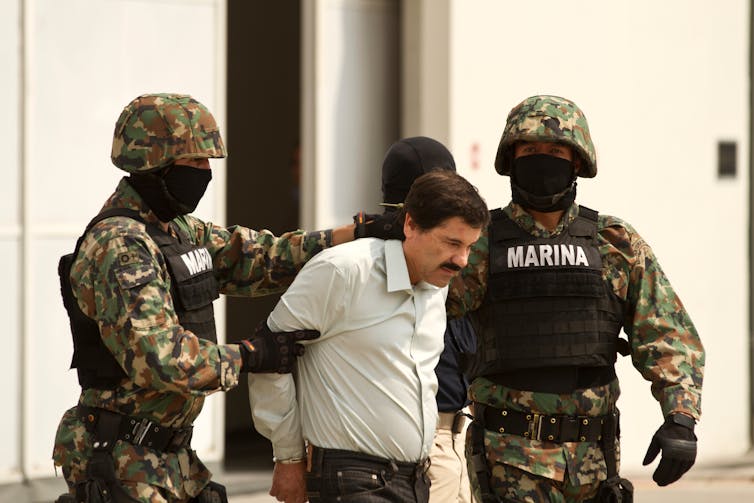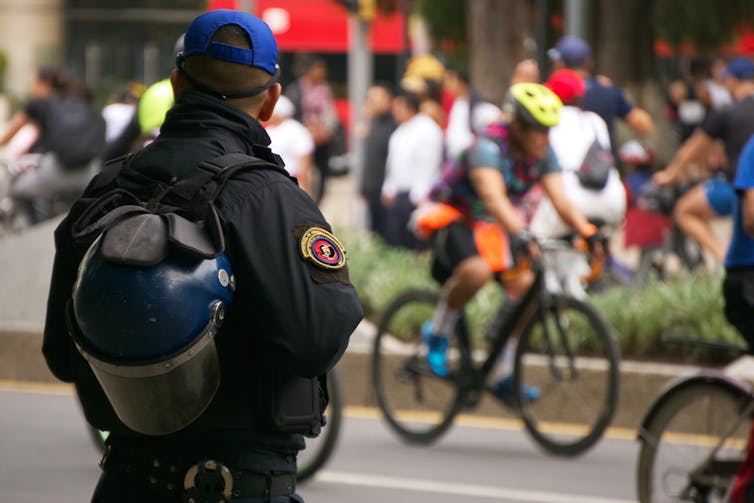Claudia Sheinbaum has become Mexico’s first female president, taking over from her popular predecessor Andrés Manuel López Obrador (Amlo). However, she has inherited a country rife with violence and faces an uphill battle to rein it in.
Mexico’s 2024 election season was the country’s deadliest on record. Dozens of candidates, as well as their relatives and other party members, were assassinated in the run-up to polling day. And three further candidates were killed in the days following the vote after winning their respective races.
Now, the state of Sinaloa in northern Mexico is being rocked by a brutal gang war. More than 90 people have been killed over the past couple of months, with local media reporting that corpses have been found with sombreros on their heads or with pizza slices pegged onto them with knives.
The violence is believed to pit gang members loyal to Joaquín “El Chapo” Guzmán Loera, the imprisoned co-founder of the Sinaloa cartel, against others aligned with Ismael “El Mayo” Zambada, the cartel’s other founder.
Violence had been widely expected. Zambada was arrested by US federal agents in July near El Paso, Texas, together with El Chapo’s son, Joaquín Guzmán López. Following his arrest, Zambada claimed that he had been abducted by the younger Guzmán and taken to the US against his will.
Read more: Mexico: leading members of the Sinaloa cartel arrested in huge symbolic win for the US
Amlo has laid the blame for the recent cartel killings, at least in part, on the US. When asked on September 19 whether the US was jointly responsible for the uptick in violence in Sinaloa, Amlo said: “Yes, of course … for having carried out this operation.”

Since Amlo took office in 2018, his policy towards organised crime has been based on the slogan: “Abrazos, no balazos” (Hugs, not bullets).
The answer to violence, for him, is not more violence. He has instead placed the focus on economic development and the implementation of measures to address poverty, social injustice and the lack of job opportunities for working people in Mexico.
However, the data shows that there has been a record number of homicides during Amlo’s presidency. More than 171,000 murders took place in Mexico between 2019 and 2023, which is far higher than under either of the country’s two previous presidents.
Amlo has insisted in his daily press conferences that there is no impunity for crimes in Mexico. However, the killing of 47 journalists during Amlo’s presidency, some of whom were exposing the crimes perpetrated by the cartels, have mostly gone unpunished.
The reason for that is that governmental and local officials are often corrupted and compliant with the cartels – a situation that Amlo’s administration has done little to change. In 2015, a Mexican journalist called Moisés Sánchez who reported on corruption and violence in the eastern state of Veracruz was found dead after being abducted from his home.
According to the state prosecutor at the time, Luis Ángel Bravo, a former police officer confessed to taking part in the murder of Sánchez. Bravo told reporters that the suspect said he had acted on orders from local mayor Omar Cruz. The mayor denied the accusation but soon fled and has been a fugitive ever since.
More of the same?
Sheinbaum, as Amlo’s protégé, may continue the pacifistic stance of his administration towards organised crime. She appealed to voters largely by promising to cement his legacy, and has vowed to continue some of his policies.
However, after being elected president in June, she pledged: “I commit myself to you to lead Mexico along the path of peace, security, democracy, freedom, equality and justice.” And Sheinbaum is certainly no stranger to tackling crime.
During her tenure as mayor of Mexico City from 2018 to 2023, Sheinbaum claimed to have halved the number of murders in the city by installing more security cameras and giving the police more power to monitor areas with high crime rates.
But there are questions over the feasibility of rolling out the same measures on a much larger scale. And, even if they were, whether they will provide the same level of success is anybody’s guess.

So, what can Sheinbaum do to stem the violence? Building on Amlo’s efforts to help young people – the societal group most exposed to cartel recruitment – find stable employment is one potential solution.
In 2019, the Mexican government introduced an employment programme called Jóvenes construyendo el futuro (Youth building the future) to give unemployed and uneducated young men opportunities to develop their skills in an attempt to reduce their participation in criminal violence.
However, these kind of programmes may be targeting the wrong people. Research has found that most of the young men that are currently recruited by criminal organisations in Mexico were not unemployed beforehand, but instead working in precarious conditions.
In fact, data shows that 70.7% of the young men who are imprisoned in Mexico for murder have worked in agricultural and manual jobs with low wages and no access to social security. It is these people, for whom the cartels are an attractive alternative, that Sheinbaum must focus on.
She also needs to coordinate with the US, Colombia and governments across Central America in their efforts to fight crime. Research shows that Colombia’s drug seizure policy has increased the profitability of the narcotics trade and, subsequently, has given rise to more violence in the Mexico.
One study, for instance, found that the decline in cocaine supply in Colombia between 2006 and 2009 could have contributed to as much as 14% of the increase in violence in Mexico over the same period.
People throughout Mexico expect Sheinbaum to tackle the violence spreading across the country. But to do so, she must be prepared to step out from her predecessors shadow, or else Mexico could soon be on a brink of a disaster.
Katia Adimora does not work for, consult, own shares in or receive funding from any company or organisation that would benefit from this article, and has disclosed no relevant affiliations beyond their academic appointment.
This article was originally published on The Conversation. Read the original article.







